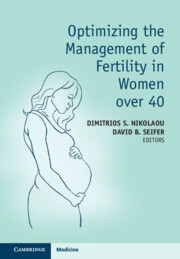Book contents
- Optimizing the Management of Fertility in Women over 40
- Optimizing the Management of Fertility in Women over 40
- Copyright page
- Dedication
- Contents
- Contributors
- Introduction
- Section 1 Demographic Trends
- Section 2 Biological Basis of Female Reproductive Aging: What Happens to the Ovaries and the Uterus as they Age?
- Chapter 2 Biological Basis of Female Reproductive Aging: What Happens to the Ovaries and Uterus as They Age?
- Section 3 Lifestyle, Environment, and Optimizing Reproduction in the 40s
- Section 4 Rethinking and Redefining “Family Planning” for the Twenty-First Century
- Section 5 Optimal Deployment of ART beyond 40
- Section 6 Obstetric Management beyond 40
- Section 7 Children of Older Parents
- Section 8 What Are Realistic Alternatives to Conceiving with Autologous Eggs?
- Section 9 New Technologies
- Section 10 Ethics
- Index
- References
Chapter 2 - Biological Basis of Female Reproductive Aging: What Happens to the Ovaries and Uterus as They Age?
from Section 2 - Biological Basis of Female Reproductive Aging: What Happens to the Ovaries and the Uterus as they Age?
Published online by Cambridge University Press: 15 September 2022
- Optimizing the Management of Fertility in Women over 40
- Optimizing the Management of Fertility in Women over 40
- Copyright page
- Dedication
- Contents
- Contributors
- Introduction
- Section 1 Demographic Trends
- Section 2 Biological Basis of Female Reproductive Aging: What Happens to the Ovaries and the Uterus as they Age?
- Chapter 2 Biological Basis of Female Reproductive Aging: What Happens to the Ovaries and Uterus as They Age?
- Section 3 Lifestyle, Environment, and Optimizing Reproduction in the 40s
- Section 4 Rethinking and Redefining “Family Planning” for the Twenty-First Century
- Section 5 Optimal Deployment of ART beyond 40
- Section 6 Obstetric Management beyond 40
- Section 7 Children of Older Parents
- Section 8 What Are Realistic Alternatives to Conceiving with Autologous Eggs?
- Section 9 New Technologies
- Section 10 Ethics
- Index
- References
Summary
The loss of oocytes and reduced oocyte quality contribute to age-associated ovarian decline and decreased fertility, which is at odds with the social trend toward delayed family building. Females are born with a finite cohort of germ cells, arrested from mid-gestation, and they progressively lose them throughout their reproductive lifespan, reaching a state of near depletion at menopause. Declining oocyte number, however, is not the sole culprit for age-related infertility. Oocyte competence, the ability to fertilize, develop, implant, and produce a live offspring, deteriorates more or less in concert with declining ovarian reserve. The uterus likely also plays a role, further hindering reproduction later in life, though additional studies are needed.
Keywords
- Type
- Chapter
- Information
- Optimizing the Management of Fertility in Women over 40 , pp. 19 - 26Publisher: Cambridge University PressPrint publication year: 2022



